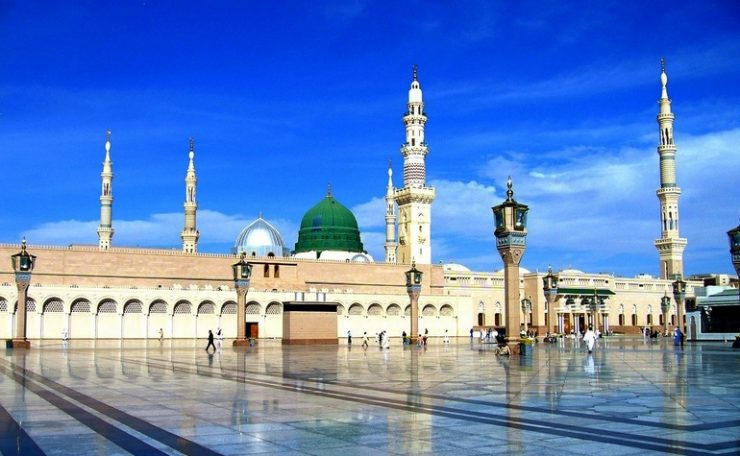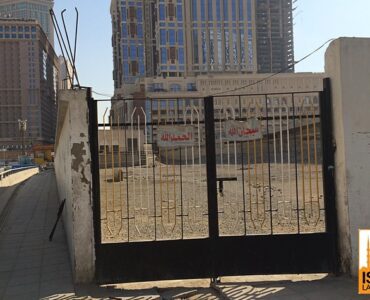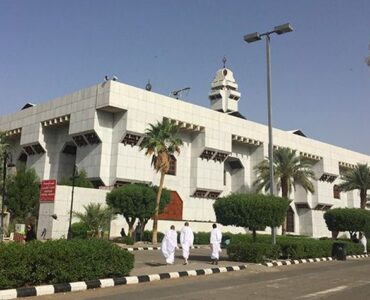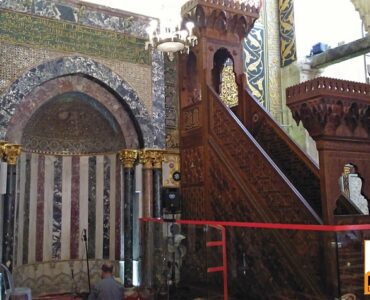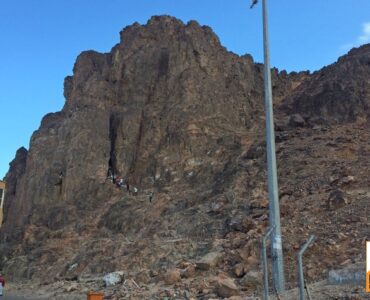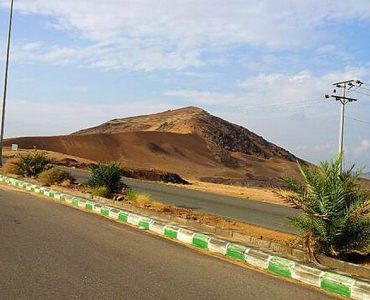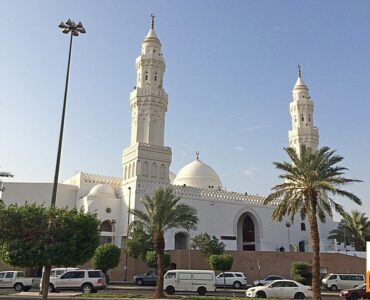Masjid-e-Nabwi (Arabic: المسجد النبوي) is the masjid (mosque) established by the Prophet (ﷺ) upon his migration to Madinah. It is the second most revered masjid in Islam and the second largest in the world, after Masjid al-Haram in Makkah.
- When the Prophet (ﷺ) migrated to Madinah (then called Yathrib), the chiefs of the city and his immediate followers rode around his camel in their best clothes and in glittering armour. Everyone was hoping he would stop by their house. The Prophet (ﷺ) would answer everyone politely and kindly, “[This camel] is commanded by Allah; wherever it stops, that will be my home.” The camel moved on with slackened reins, reaching the site of the present masjid and knelt down. The Prophet (ﷺ) alighted and said, “This is the home” and inquired as to who owned the land. The land contained a few date trees, graves of polytheists, a resting spot for herds of cattle and was owned by two orphan brothers, Sahl and Suhail. The Prophet (ﷺ) purchased the land, had the trees cleared and the polytheists graves dug up and levelled.
- He then gave orders that his newly acquired courtyard should be made into a masjid and work began immediately. Most of the building was done by bricks made of stones and kneaded clay but in the middle of the northern wall (which faced the original Qibla in Jerusalem) stones were put on either side of the prayer niche. The palms in the courtyard were cut down and their trunks were used as pillars to support the roof of palm branches, but the greater part of the courtyard was left open. Small stones were laid on the floor to prevent it from becoming too muddy. At the rear of the masjid, the Prophet (ﷺ) built a shaded area called as-Suffah in which the poor companions would spend the night. Two small huts were also constructed on the eastern side of the masjid to accommodate his two wives at the time, Aisha and Sauda (رضي الله عنهم).
- The Prophet (ﷺ) gave the Muslims of Madinah the title of ‘Ansar’ which means Helpers, whereas the Muslims of Quraysh and other tribes who had left their homes and emigrated to the oasis he called ‘Muhajirun’, meaning Emigrants. All took part in the work, including the Prophet (ﷺ) himself, and as they worked they chanted two verses which one of them had made up for the occasion: “O Allah, no good is but the good Hereafter, So help the Helpers and the Emigrants.” And sometimes they chanted: “No life there is but the life of the Hereafter. Mercy, O Allah, on Emigrants and Helpers.”
- The masjid was built twice during the lifetime of the Prophet (ﷺ). The first time was shortly after he had made the Hijra to Madinah in 622 CE, with the size of the masjid being approximately 35 x 30 meters and the height 2.5 meters. It was rebuilt seven years later after the Fath (opening) of Khaibar. The increasing number of Muslims by then necessitated an increase in the area of the mosque to accommodate more worshippers. Usman (رضي الله عنه) paid for the land to accommodate the extension which made the masjid approximately 50 x 50 meters. The height was also increased to 3.5 meters.
- When the revelation came down to change the Qibla to Makkah in 624 CE, the whole masjid was re-orientated to the south.
- The masjid also served as a religious school, community center, court and also as a confinement for prisoners.
- Anas (رضي الله عنه) reports that the Prophet (ﷺ) said: “Whoever performs forty salah in my masjid, not missing one salah in the masjid, for him is granted exemption from the fire of Hell, and exemption from punishment and he shall remain free of hypocrisy.” [Ahmad]
- Abu Hurairah (رضي الله عنه) narrated that the Prophet (ﷺ) said:“One salah offered in my masjid is superior to one thousand salahs offered in other masjids except Masjid al-Haram (Makkah al-Mukarramah).” [Bukhari]
References: History of Madinah Munawwarah – Dr. Muhammad Ilyas Abdul Ghani, Wikipedia, History of Madina – Ali Hafiz, Encyclopedia of Islam – Al-Arabee Ben Razzouq, Virtues of Hajj – Sheikh Muhammad Zakariyya Kandhalvi

